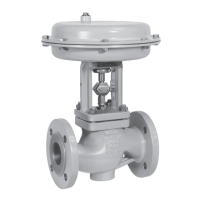18
Competence in Functional Safety
Functional safety of globe valves, rotary plug valves, ball valves and butterfly valves
5.5 Rotary plug valve requirements Responsibility
On sizing actuators, note that the actuator must provide sufficient torque to over-
come the closing torque in closed position as well as the dynamic torque in open
position.
Adjustable stem packings are to be tightened by qualified staff only to prevent the
stem from becoming blocked.
To prevent corrosion of the actuator springs, measures must be taken to prevent water
or moisture from entering the actuator. Such measures include fitting a venting pipe
or air purging of the actuator‘s spring chamber.
The proper mounting of the valve onto the actuator is of vital importance.
The permissible torques for the valve shaft, shaft adapter and bridge have been
verified by the manufacturer. As a result, the max. torque of the actuator (air or
spring torque) must not exceed these torques under any circumstances.
The corresponding specifications in accordance with DIN EN ISO 5211/DIN EN 15081
(NAMUR Recommendation NE 14) must be observed. See section 5.3 on ball valve
requirements.
Operator
Manufacturer
5.6 Proof tests and service life
The proof test interval and the extent of the test lie within the operator‘s responsibility.
This must be documented correspondingly.
During the proof test, suitable means must be used to test the control valve to ensure
its proper functioning. Worn components must be replaced by original spare
parts from the manufacturer.
The maximum service life must be specified.
It is recommended to summarize the requirements of the proof test in a checklist.
Refer to Appendix 2 for an example.
Operator

